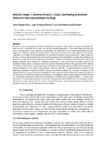Resilient Design in Extreme Climates: 5-Steps Overheating Assessment Method for Naturally Ventilated Buildings

Use this link to cite
http://hdl.handle.net/2183/40777
Except where otherwise noted, this item's license is described as Atribución-NoComercial-SinDerivadas 3.0 España
Collections
- Investigacion (ETSAC) [511]
Metadata
Show full item recordTitle
Resilient Design in Extreme Climates: 5-Steps Overheating Assessment Method for Naturally Ventilated BuildingsDate
2022-04-19Citation
Zepeda-Rivas, D. Rodríguez-Álvarez, J., & García-Chávez, J.R. (2022). Resilient Design in Extreme Climates: 5-Steps Overheating Assessment Method for Naturally Ventilated Buildings. En F. Nicol, H. Bahadur Rijal, & S. Roaf, Routledge Handbook of Resilient Thermal Comfort (Part II. Chapter 5). Routledge/Taylor & Francis Group.
Abstract
[Abstract]
Owing to human-induced global warming, overheating has become a major factor in energy consumption, the main source of discomfort and a health risk for the vulnerable population. It has been widely reported how human mortality rises during heatwaves. Paradoxically, the inhabitants of air-conditioned buildings are often exposed to artificially created low temperatures increasing the thermal shock with respect to the outdoor conditions. As a result of the popularization of mechanical systems, energy consumption peaks during hot periods. A vicious loop emerges as CO2 and greenhouse gas emissions generated to mitigate the consequences of global warming will further contribute to exacerbate it. Despite the magnitude of the problem, there is no broadly accepted single method for measuring overheating in naturally ventilated buildings. Most of the published methods rely on a simple count of hours above a theoretical comfort limit, regardless of the intensity and temporal extent of the overheating periods. This deterministic approach makes difficult the introduction of passive strategies as it falls short of accounting for adaptive measures. This paper proposes a novel five-step overheating assessment method (5-SOAM) in naturally ventilated buildings. The study aims to provide a more flexible framework to assess the actual suitability of indoor spaces for human habitation through an analysis of the likelihood of overheating frequency and intensity. The proposed method applies adaptive comfort theories and it has been conceived to account for acclimatization in Tropical and Subtropical regions. It is based on the tabulation of overheating occurrence in five bands, reflecting the thermal difference from the upper comfort threshold (i.e., hours above 0.1°K, 1°K, 2°K, 3°K, and 4°K). The output of the method provides a sensitive index that determines the scale of overheating risk in buildings.
Keywords
Built environment
Description
This is an Accepted Manuscript of a book chapter published by Routledge/CRC Press in Routledge Handbook of Resilient Thermal Comfort on, 19 April 2022, available online: http://www.routledge.com/9781003244929
Editor version
Rights
Atribución-NoComercial-SinDerivadas 3.0 España
ISBN
9781003244929






